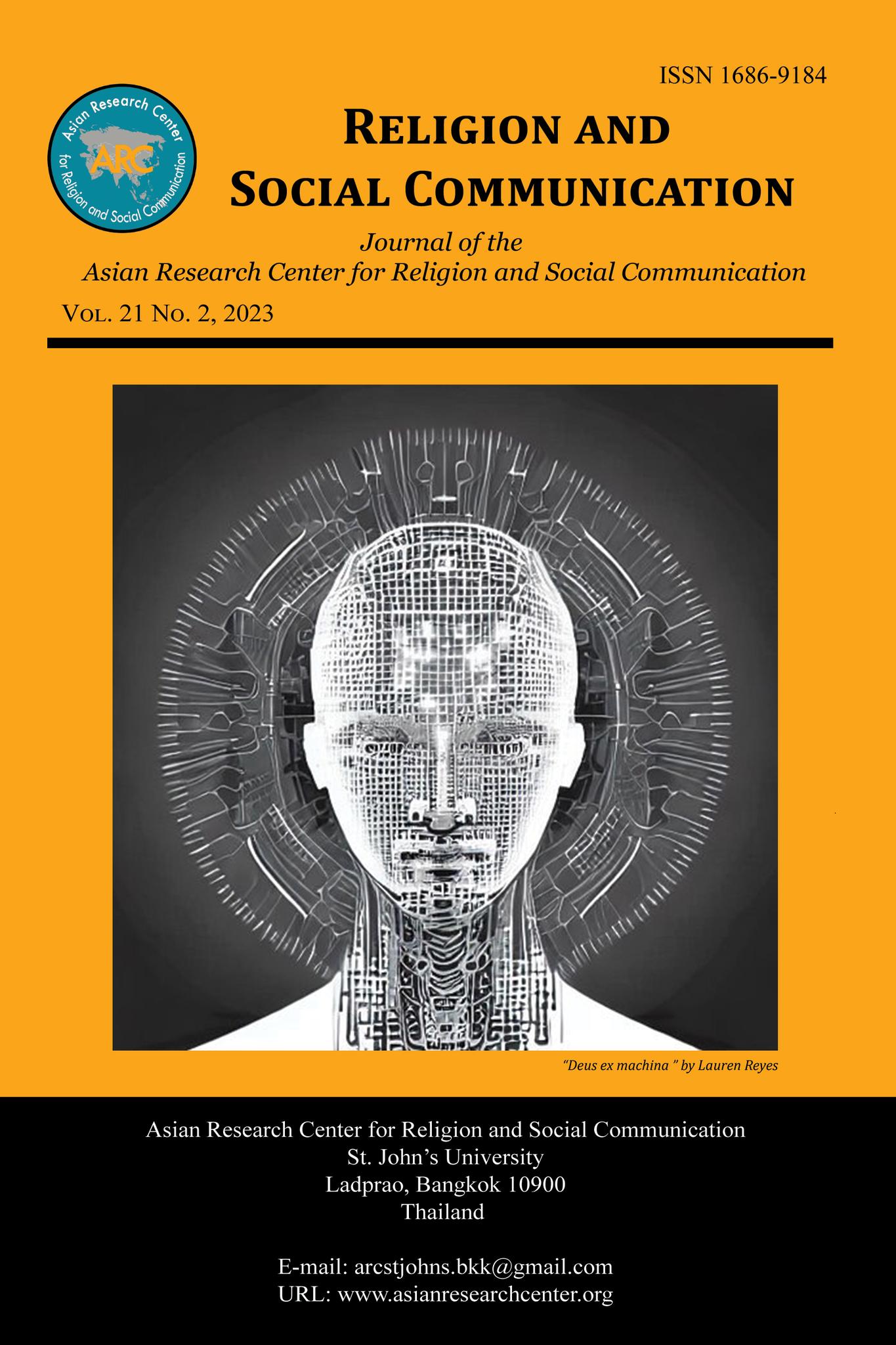From Icons to AI: Evolution of Imagery in Religious Communication
RELIGION AND SOCIAL COMMUNICATION VOLUME 21, NO. 2 (2023)
ISSN 1686-9184
Author
Bryan B. Albia, Mariel B. Blanza, and Andrew Joseph S. Chanco
Abstract
Using icons in religious communication is a widespread practice that dates back many centuries. In various religions, icons have been instrumental in conveying religious messages, themes, and beliefs as religious leaders, artists, and craftsmen utilized icons to represent religious stories, rituals, and events visually. One of the main reasons images are used in religious communication is that they can effectively convey complex ideas and emotions that may be difficult to express through words alone. Thus, icons help not only to beautify sacred spaces but to make abstract concepts more tangible and accessible, making it easier for people to engage and understand otherwise lofty and abstract religious teachings. They also serve as powerful and evocative tools for inspiring devotion and promoting practices that can lead to increased participation in religious rituals and a more profound sense of connection to one’s faith. This paper aims to present the evolution of icons and understand whether AI-generated icons made possible today by generative AI tools can be employed in religious communication. In presenting the said theme, the following topics are unfolded: first, the use of symbols and icons across religions; second, the evolution of using images in various faiths; and third, the advent of AI-generated icons and the possibility of employing them as mediums of religious communication and education.
Keywords
AI, icons, images, sacred images, religious communication
References
Avis, Paul. God and the Creative Imagination: Metaphor, Symbol, and Myth in Religion and Theology. New York: Routledge, 1999.
Begbey, Jeremy. Beholding the Glory: Incarnation Through the Arts. Grand Rapids, MI: Baker Books, 2000.
Belting, Hans. “Iconic Presence: Images in Religious Traditions.” Material Religion 12, no. 2 (2016): 235-237. DOI: 10.1080/17432200.2016.1172769.
Burkepile, Jacqueline. “No, the Vatican DID NOT Make a Deal with Balenciaga for a ‘Spiritual’ Clothing Line.” ChurchPOP, July 10, 2023. https://www.churchpop.com/no-the-vatican-did-not-make-a-deal-with-balenciaga-for-a-spiritual-clothing-line/.
David, Rosalie. “Ancient Egypt.” In A Handbook of Ancient Religions, edited by John R. Hinnells, 46-104. Cambridge: Cambridge University Press, 2007.
Dorobantu, Marius. “Artificial Intelligence as a Testing Ground for Key Theological Questions.” Zygon Journal of Religion & Science 57, no. 4 (2022): 835-1155. https://onlinelibrary.wiley.com/doi/full/10.1111/zygo.12831
Edwards, Emanuela. “Survey of Audience Reception in the Sistine Chapel: Decoding the Message of Sacred Art.” Church, Communication, and Culture 3, no. 3 (2018): 260-282. https://www.tandfonline.com/doi/full/10.1080/23753234.2018.1539625.
Fortescue, Adrian. “Veneration of Sacred Images.” The Catholic Encyclopedia, July 10, 2023. http://www.newadvent.org/cathen/07664a.htm.
Foster, Benjamin R. “Mesopotamia.” In A Handbook of Ancient Religions, edited by John R. Hinnells, 161-213. Cambridge: Cambridge University Press, 2007. DOI:10.1017/CBO9780511488429.005.
Francis. “Address to Participants in the “Minerva Dialogues.” Vatican Website, March 27, 2023. https://www.vatican.va/content/francesco/en/speeches/2023/march/documents/20230327-minerva-dialogues.html.
Francis. “World Communications Day Message.” Vatican Website, January 23, 2021. https://www.vatican.va/content/francesco/en/messages/communications/documents/papa-francesco_20210123_messaggio-comunicazioni-sociali.html.
Geraci, Robert M. “Apocalyptic AI: Religion and the Promise of Artificial Intelligence.” Journal of the American Academy of Religion 76, no. 1 (2008): 138-166.
Grabar, André. Christian Iconography: A study of its origin in Bollingen. Series 35. Princeton, N.J.: Princeton University Press, 1980.
Grabar, Oleg. “From the Icon to Aniconism: Islam and the Image.” Museum International 55, no. 2 (2003): 46-53. DOI: 10.1046/j.1350-0775.2003.00425.x.
Hubbard, Guy. “Images of Devotion: Arts & Activities.” July 11, 2023, https://0search.ebscohost.com.ustlib.ust.edu.ph/login.aspx?direct=true&db=asn&AN=9603263510&site.
Kenna, Fed Margaret E. “Icons in Theory and Practice: An Orthodox Christian Example.” History of Religions 24, no. 4 (1985): 345-368. http://www.jstor.org/stable/1062307.
Little, Stephen H. and T. Lawrence Larkin, “Buddhism.” Northeastern Asia and the Northern Rockies. (2022) DOI: https://doi.org/10.53288/0383.1.00
Neamt, Florentina. “Religious Symbols and Communication in Public Administration.” Economy Transdisciplinarity Cognition 24, no. 1 (2021): 56 – 62.
Ocampo, Jennifer. “Ancient Deities.” Ancient Art, April 24, 2015, https://ancientart.as.ua.edu/ancient-deities/.
Ouspensky, Leonid. Theology of the Icon, Volumes 1 & 2. Crestwood: St. Vladimir’s Seminary Press, 1992.Possehl, Gregory L. “The Indus Civilization.” In A Handbook of Ancient Religion, edited by John R. Hinnells. (418-489) Cambridge: Cambridge University Press, 2007.
Reimer, Jeff. “Images of the Invisible God.” Commonweal Magazine, Vol. 149, no. 2 (February 2022). https://commonwealmagazine.org/sites/default/files/imce/31076/Commonweal_2.2022_Discussion%20%281%29.pdf
Schieppati, Sara Valentina, et al. “Religious and Sacred Art: Recent Psychological Perspectives.” Ricerche Di Psicologia 45, no. 1 (2000): 3. DOI:10.3280/rip2022oa13589.
Sheen, Seung Heon. “Can AI Paint an Icon?” Transpositions, May 26, 2023. https://www.transpositions.co.uk/can-an-ai-paint-an-icon/?fbclid=IwAR3FNM7OuVZ05FvW4DN91-HMMgIxcY-Wvqy8zC8o8QmNNS57YxbXRg5c8Qg
Singler, Beth. “The AI Creation Meme: A Case Study of the New Visibility of Religion in Artificial Intelligence Discourse.” Religions 11, no. 5. (2020): 253. DOI:10.3390/rel11050253. https://www.mdpi.com/2077-1444/11/5/253
Stephen, Little et al. Taoism and the Arts of China. Chicago: The Art Institute of Chicago, 2000. https://archive.artic.edu/taoism/introduction.php.
Tsakiridou, C.A. Icons in Time, Persons in Eternity: Orthodox Theology and the Aesthetics of the Christian Image. England: Ashgate Publishing Company, 2013.
Zahra, Astaneh. “The Representation of God in Islam and Its Prohibition: Strategies Used by Iranian Children When Asked to Draw God: New Approaches to Scientific Religion.” In When Children Draw Gods: A Multicultural and Interdisciplinary Approach to Children’s Representations of Supernatural Agents, edited by Pierre-Yves Brandt et al., 397-424. Springer Cham, 2023. DOI: 10.1007/978-3-030-94429-2. https://link.springer.com/chapter/10.1007/978-3-030-94429-2_15.
Zibawi, Mahmoud. The Icon: Its Meaning and History. Collegeville: The Liturgical Press, 1993.
PAGES: 270-293
DOI: https://doi.org/10.62461/BMA112923
Submitted: Sempteber 15, 2023; Accepted: November 29, 2023; Published: December 31, 2023




